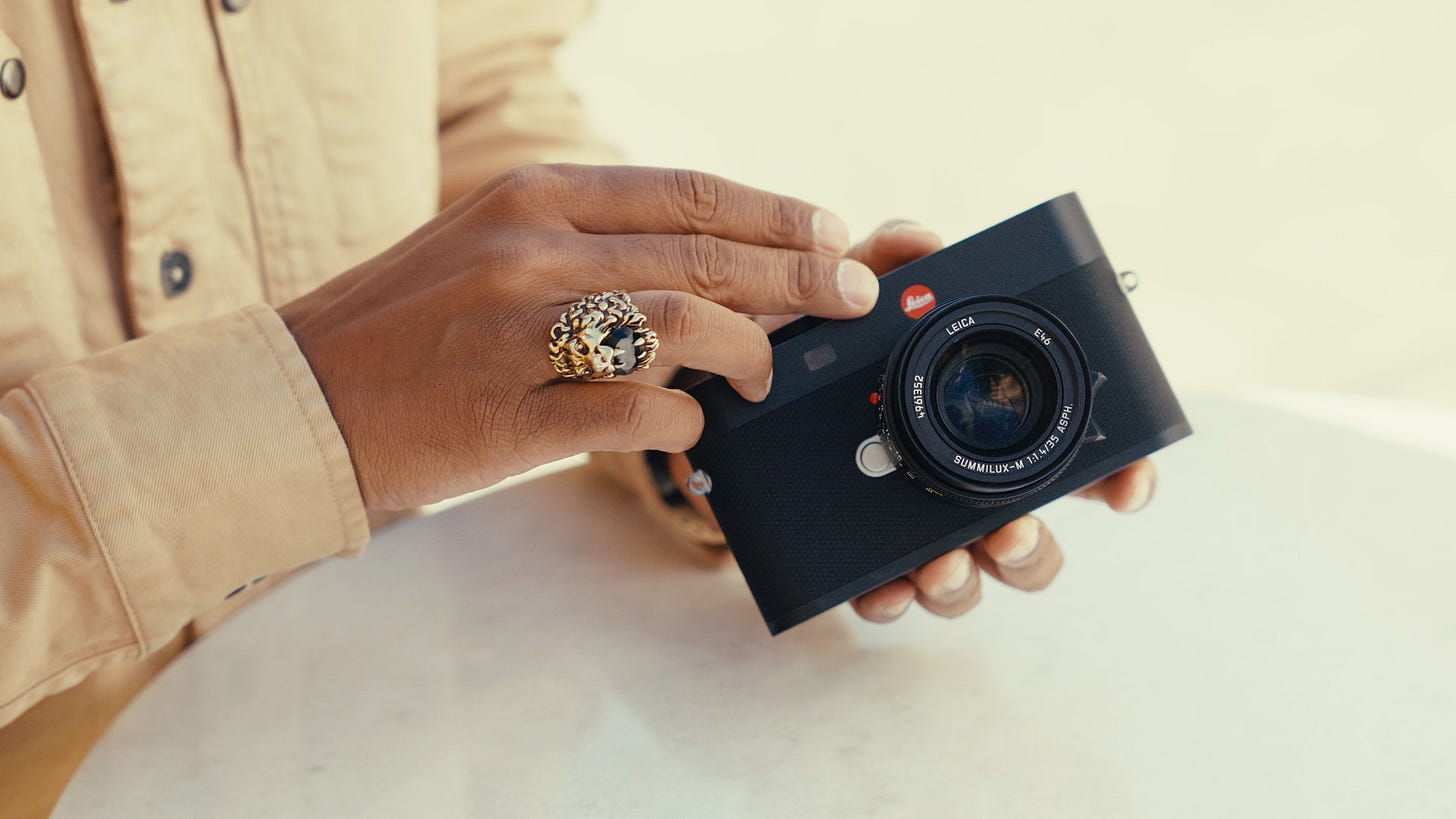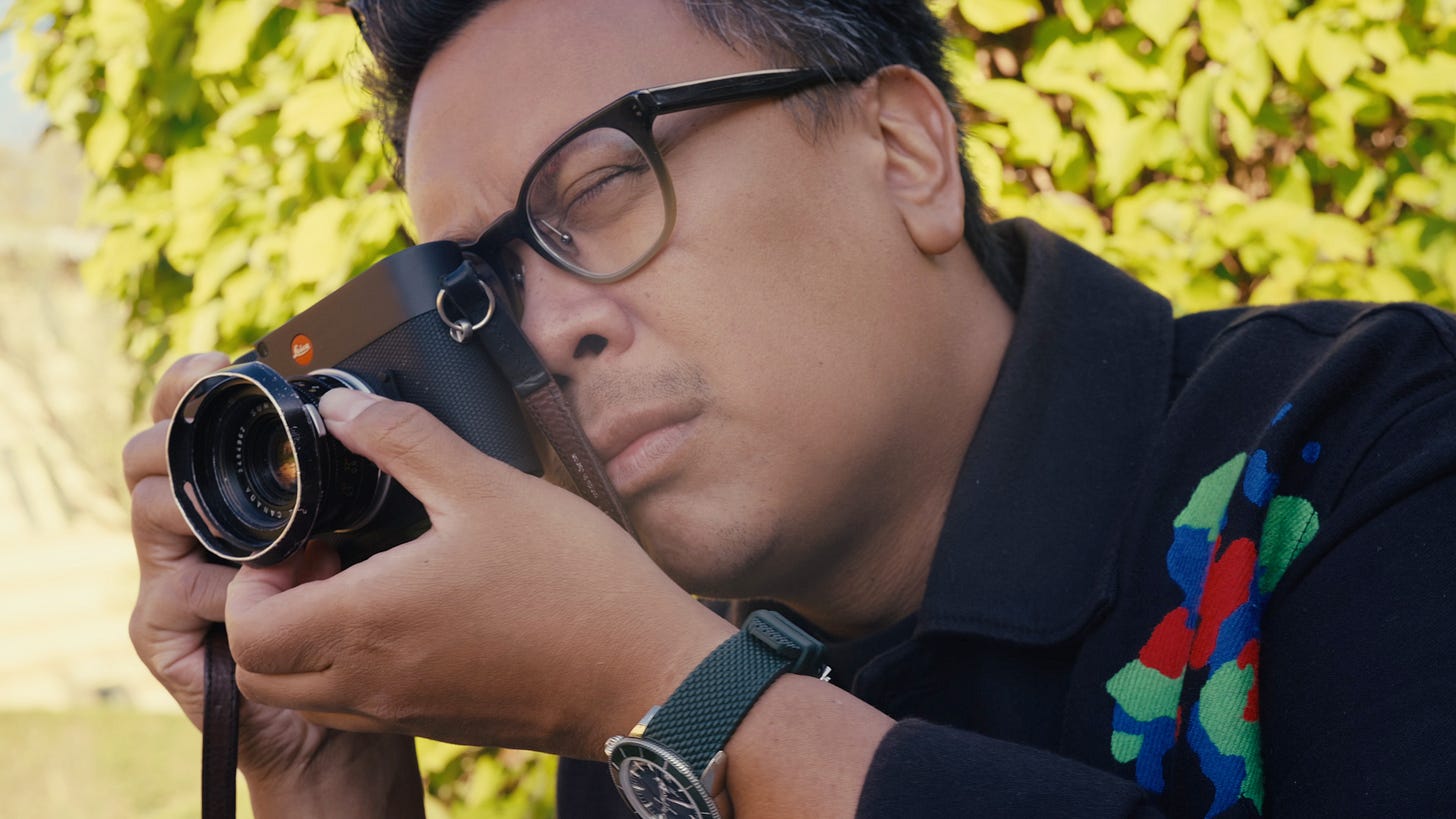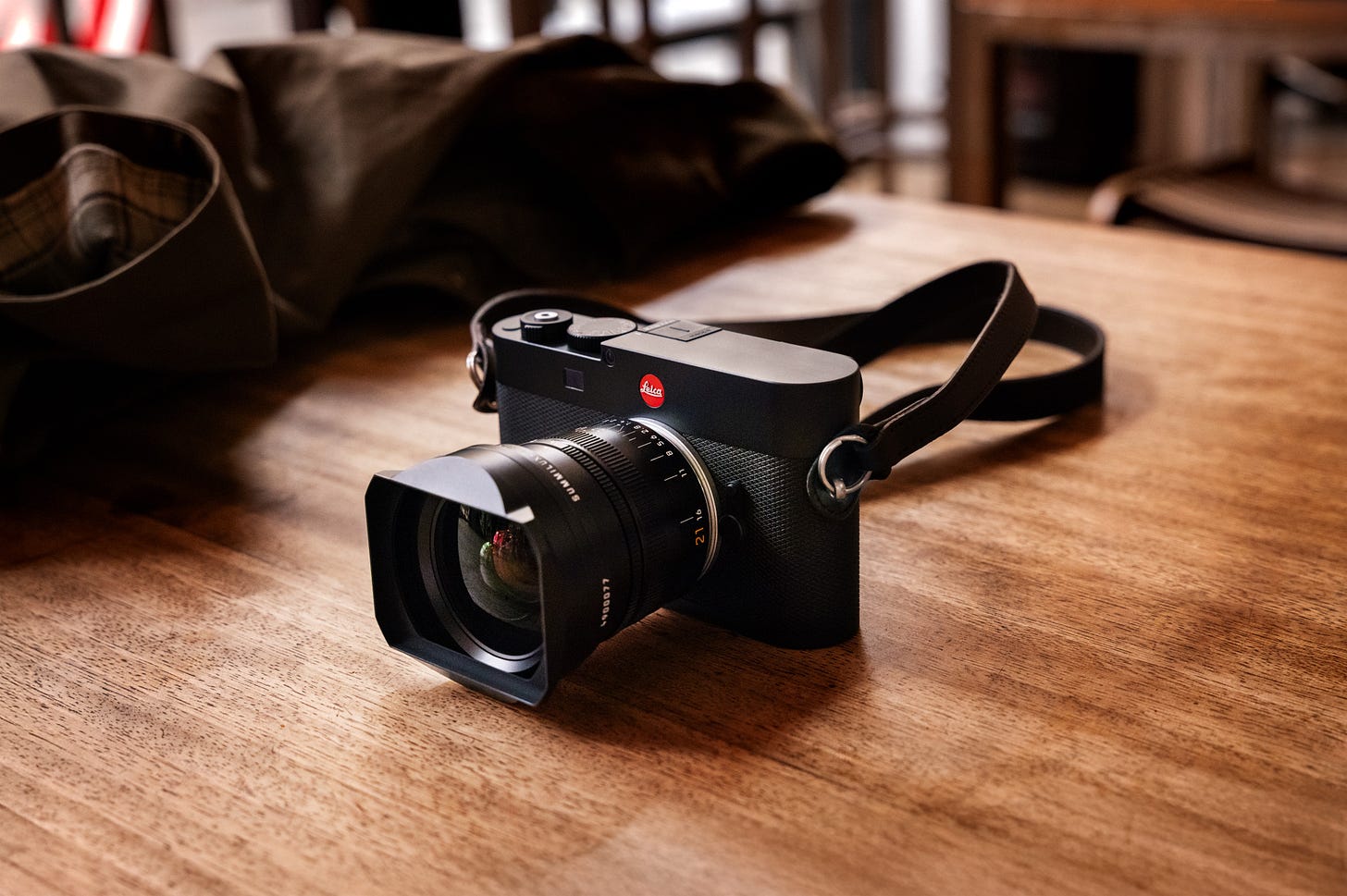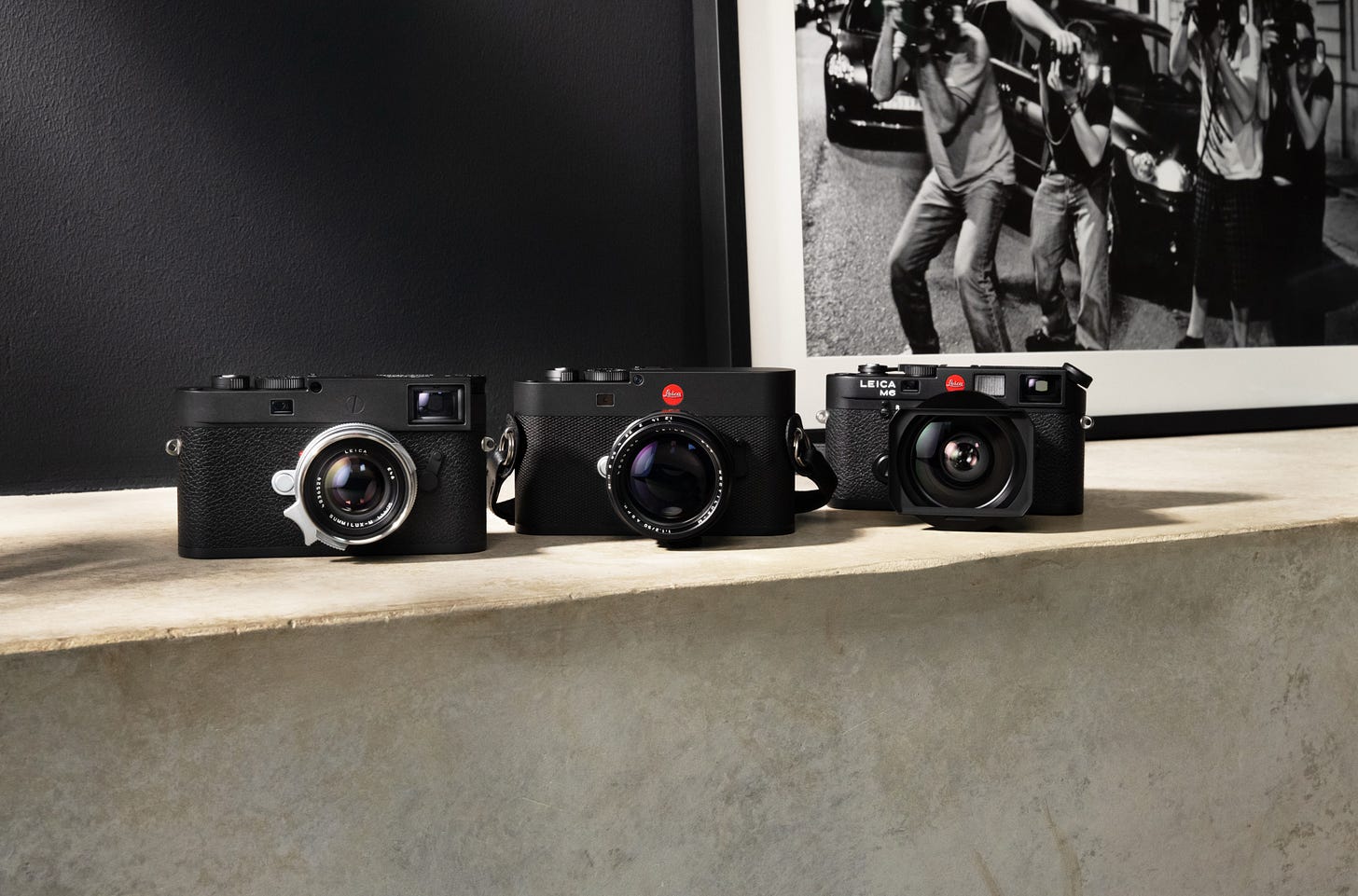Introducing the Leica M EV1
A deep-dive into Leica's first M camera with an EVF
Last month, I was among a small group of Leica Ambassadors invited to Piedmont, Italy for an exclusive preview of Leica’s next addition to the M family of cameras: the Leica M EV1. Along with a select group of press and media, I spent the better part of a week test-driving this new tool to understand how it fits in the market and who should be most excited about it.
A New Chapter in the M Story
When we were first briefed on the M EV1, I wasn’t sure how it fit into the M story. But after a few days with it, it finally clicked. It’s not about the rangefinder. It’s about the mount.
The M mount has been around since 1954, giving us more than seventy years of optical history. With this release, there are now three ways to experience it. If you’re a purist, you can take the analog route with cameras like the Leica M6, MP, or M-A. If you crave the rangefinder experience with a digital pipeline, there’s the M11 family. And now, for those who want access to this mount while seeing their final frame with absolute clarity, there’s the M EV1.
When I think about this camera, it comes down to four words: wider, tighter, older, newer.
You can shoot wider lenses and see your entire frame. You can shoot tighter lenses and still see your frame. You can mount vintage glass and truly appreciate its character, especially in the out-of-focus areas. And you can mount modern lenses with close-focusing capabilities and still have a perfect view throughout the focusing range.
That’s the real magic here. The M EV1 isn’t here to replace your rangefinder. It’s an alternative, another way to experience the M mount. It’s for people who want the Leica M silhouette, the manual focus experience, and the legacy of M glass, but in a way that feels more fluid for how they shoot today.
What’s With The Name?
So, why is it called the M EV1 and not something like the M11-V? I asked that question to Christoph Mueller, Senior Product Manager at Leica Camera AG and the lead behind this release. The answer: because this camera sits in its own category alongside the M11, not beneath it.
Leica is creating a new segment in its portfolio, one that blends the legacy of the M with the accessibility of the Q. And in their eyes, that deserves its own category. The M EV line.
Familiar And Formidable
The standout feature of the Leica M EV1 is the 5.76-million-dot electronic viewfinder that replaces the historic rangefinder. It’s the same panel used in the Leica Q3, but adjusted to fit the tighter tolerances of an M body. When you look through it, the experience feels as familiar as peering through the Q window.
The M EV1 also brings a suite of features familiar to the M11 family:
60MP full-frame BSI sensor with Triple Resolution Technology
Maestro III processor
Native ISO range of 64 to 50,000
SD UHS-II card slot and 64GB of internal storage
Mechanical shutter up to 1/4000
Flash sync up to 1/180
Continuous shooting up to 4.5fps
Content Credentials support
If it wasn’t clear already, the Leica M EV1 isn’t trying to reinvent the wheel. It’s expanding the M family with an electronic viewfinder experience that’s more accessible to a wider gamut of photographers.
Elegance
The design of this camera is nothing short of elegant. With the removal of the optical viewfinder, you get a clean profile that radiates quiet sophistication. Keen observers will notice what looks like a rangefinder window on the front. That’s actually where the self-timer indicator light sits. A subtle nod to the M legacy wrapped in modern functionality.
Now, what about that red dot? Why is it centred, and why include it at all? I asked Stefan Daniel, Vice President of Photo and Design at Leica Camera AG, known affectionately as “Mr. M.” He told me the logo placement was intentional. The idea was to make the camera feel familiar and approachable rather than something that felt too professional. As for why it’s centred, that’s because the EVF panel runs so close to the edge of the top plate that placing the logo toward the edge else simply wasn’t an option.
What is borrowed from the Q family, however, is the diamond-patterned leatherette that wraps around the camera.
Staying on the front, the frame selector lever now serves a new purpose. It’s been redesigned as a custom function lever that you can push or pull. You can assign these movements to one of three functions: focus peaking, magnification, or digital zoom. It’s an ingenious little detail that made me genuinely excited the first time I tried it.
Looking at the top plate, you’ll notice the ISO dial is gone. That’s expected, given the inclusion of an EVF. And even though space inside this body is tight, removing the rangefinder optics makes the M EV1 significantly lighter than other M cameras. At 484 grams with a battery, it feels nearly effortless compared to the M11-P, which weighs around 640 grams.
The back of the camera feels familiar but adds an expected change: a diopter adjustment wheel that lets users push and twist to fine-tune their view.
All in all, the Leica M EV1 takes an already classic silhouette and introduces a few well-considered innovations that make the camera feel both timeless and forward-looking.
How Does It Shoot?
The design and features come together to create an experience that feels fluid and assured. Quite simply, it’s the fastest M camera to use. There’s a muscle memory that rangefinder users know well: focus, then recompose. You no longer need to do that here. You compose, focus, and shoot in one seamless motion.
When using a modern close-focusing lens below 0.7 meters, you don’t have to take your eye off the viewfinder to check the LCD for focus. You stay in the moment. You frame, focus, and shoot with confidence.
While the M EV1 feels right at home on the streets, it also has potential in professional environments. In the studio or on client shoots, I often reach for my Leica SL3 or SL3-S first, weaving in M glass only when I can risk a little imperfection. The M EV1 might change that.
With the ability to use my favourite M lenses, see the full frame in real time, and get an experience that feel more intimate, there’s a strong case for this camera being the most versatile M yet. Time will tell, but I’m optimistic about the prospect of a higher hit rate and a smoother workflow with the M EV1
Where Have I Landed?
To paraphrase Leica’s VP of Global Marketing and Communications, Andrea Pacella: when you remove the rangefinder from a rangefinder camera, it’s no longer a rangefinder. But it’s still a camera. And in this case, it’s still an M.
The M EV1 draws from Leica’s history to create a familiar tool that captures the world around you while giving access to a rich lineage of lenses. More importantly, it makes all those lenses easier to use, offering an alternative for photographers who value accessibility, speed, and accuracy.
The M EV1 also lowers the barrier to entry for those curious about the M system. There’s a whole audience that loves the idea of Leica M cameras but finds the rangefinder mechanism intimidating. This camera removes that hurdle. You still get the iconic silhouette, the sensor, and access to seventy years of lenses, but in a way that’s simpler and more intuitive.
It’s also a gift to photographers who wear glasses or struggle with vision. The EVF makes the experience more comfortable, improves hit rate, and turns the act of photography into something more effortless and enjoyable.
This is what makes Leica special. They can create something incredibly specific, a niche within a niche, and still make it feel purposeful and poetic.
Once you start using the M EV1, you’ll immediately start rethinking your lens collection. Those four words I mentioned earlier? Wider, tighter, older, newer. That’s what truly defines this new camera. Pushing the boundaries of each, and you’ll discover an experience that feels different, but entirely confident.
The M EV1 isn’t trying to redefine the M system. It’s simply expanding it, giving photographers a new way to connect with the same soul that has defined Leica for decades.
I arrived in Italy not knowing what to expect, maybe even a little skeptical. Now, I’m genuinely excited to test-drive this camera around the world and see how it performs in every condition I can throw at it.
Upcoming Events & Workshops
Mexico City: Día de Muertos Meet-Up
I’ll be in Mexico City in early November for Día de Muertos and planning a few free meet-ups and talks. The main event is on Monday, November 3rd and you can register for free here.
Toronto Studio Photography Workshop
This November, I’m hosting a studio photography workshop designed to elevate your skills. Whether you’re a beginner looking to build a solid foundation or an experienced photographer looking to refine your craft, this workshop will educate you in the essential techniques of studio work. Full details can be found here.
Arctic 2026 Photography Adventure
In 2024, I traveled to Svalbard with Quark Expeditions and it was unforgettable. I’m planning a return trip in 2026 with a group of photographers. This is not a workshop. It’s an excuse for like-minded storytellers to visit one of the most remote places on earth. If that sounds like you, fill out this form to learn more.
Next year, I’m heading to India again for our second street photography adventure across the North and South. Seats have just been made available for those looking for a deep, immersive photography experience. Learn more here.
Previous Favourites
October Contest
This month, I’ll be giving away a $200 gift card to the Moment Shop where the winner can save big on their next camera, lens, bag, or courses. Moment has so many creative products to choose from and $200 can absolutely make for a great deal.
How will I pick the winner? Make sure you’re signed up for this newsletter then leave a comment on at least one post from this month. I’ll be randomly picking one person, confirming they meet the requirements and contacting them directly before announcing the winner publicly.
As always, this contest is void where prohibited by law. Good luck!
My thanks to the team at Moment! Not only for this contest but for being the longest supporter of my work online. They’re a lean team of passionate creators that truly believe in supporting other creatives on their journey. Whether it’s a new camera, lens, workshop, or just some great articles, visit ShopMoment.com today.
What’s Next?
I’m currently in Montreal attending my first LSI Conference as an invited speaker. If you happen to be in the city this weekend, come say hi.
GB






Thanks, Gajan. How does the EVF perform when you rapidly need to acquire focus, and towards being lag-free and blackout-free? Nikon’s Z9 is the best EVF performance I’ve used. On an autofocus camera, EVF is great, and good on the Q3, but on an M, I find it hard to believe an EVF will be quicker and more accurate in fine focus than the rangefinder. What are your thoughts?
As background, I'm going on >40 years of using M cameras. Part of the M charm is an old dog not having to learn new tricks (having recently purchased a Fuji X-E5, I hate the menu hell which is the price paid for UTD tech). I continue to use the film MP which works as my Monochrome and initially was going to wait until the EV1 to upgrade from a M10.. I went instead with the M11-P with the realization that focusing with the rangefinder was going to be easier/faster compared to an EVF and the window frames work better for me in the 28mm-50mm range which I use 95% of the time. It will be interesting to see how the Leica community adapts to manual focus with an EVF exclusively.